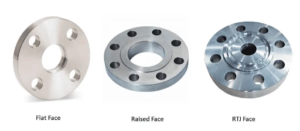Flanges play a pivotal role in connecting pipes, valves, and equipment across various industries. Understanding the different types, specifications, and applications of flanges is important for efficient and safe piping systems. This article serves as an informative guide to the world of flanges, drawing from various sources to provide valuable insights.
Catolog link: https://www.texasflange.com/wp-content/uploads/2019/06/catalog-c-v5.pdf
ASME B16.5 Pipe Flanges and Flanged Fittings
The ASME B16.5 standard, defined by the American National Standards Institute (ANSI), covers vital aspects of pipe flanges and flanged fittings:
- Pressure-Temperature Ratings: It includes information about pressure-temperature ratings, materials, dimensions, tolerances, marking, testing, and designating openings for pipe flanges and flanged fittings.
- Flange Sizes: This standard covers a wide range of flange sizes, from DN10 to DN2000 (1/2″ to 80″).
- Pressure Classes: Flanges are categorized based on their pressure class, denoted by values like PN6, PN100, 150lbs, 2500lbs, 5K, and 30K.
- Standardization: Flanges can adhere to various standards such as ANSI/ASME B16.5, DIN, or API 6A.
- Material Compatibility: Material specifications for flanges must be chosen carefully to ensure compatibility with piping material specifications.
- Pipe Schedule: Certain types of flanges require a matching bore size with the pipe.
- Additional Resources: The ASME B16.5 standard is complemented by other ASME standards such as the Boiler and Pressure Vessel Code and the B31 Piping Codes.
Different Types of ANSI Flanges
Image Source: Texas Flange
ANSI flanges, designed in accordance with American National Standards Institute specifications, are used in various applications:
- Threaded Flanges: These flanges can be integrated without welding and are ideal for applications where reusability is important.
- Slip-On Flanges: They are welded into place, and their ease of fitting makes them suitable for situations where no disassembly is anticipated.
- Blind Flanges: Used for sealing off sections of pipes and for high-pressure applications and flow testing.
- Lap Joint Flanges: These flanges allow for frequent assembly and disassembly, ideal for applications requiring regular maintenance.
More Flange Types and Specifications
Beyond ANSI flanges, numerous specifications and types are available, including:
- Orifice Flanges: Used in conjunction with orifice plates to measure or restrict pressure and flow in pipelines.
- Reducing Flanges: Designed to connect pipes with different diameters while maintaining a strong and leak-free joint.
- JIS Standard Steel Flanges: A set of standards for steel flanges used in Japan.
- GOST 12820-80 and GOST 12821-80 Flanges: Russian standards for flanges.
- DIN Flange & DIN Standard Flanges: European standard widely recognized.
- BS 3293 Slip-On Flanges: British standards for slip-on flanges.
- BS 4505 and EN 1092 Flanges: Additional European standards.
Tolerances, Inquiry, and Materials
Flange specifications adhere to tight tolerances, often within ± 0.10mm, ensuring precision in assembly. Inquiries about flanges should consider various factors like type and facing, nominal pipe size (NPS), flange pressure class, standard, material compatibility, and pipe schedule. Materials for flanges, fittings, valves, and pipelines must be chosen carefully to ensure compatibility.
Image Source: Texas Flange
FAQS(Frequently Asked Question)
- What is the primary function of a flange in a piping system?
A flange serves as a essential component in a piping system by connecting pipes, valves, and equipment, allowing for the efficient and secure transport of liquids and gases.
- What is ASME B16.5, and why is it significant in the context of flanges?
ASME B16.5 is a standard established by the American National Standards Institute (ANSI) that provides guidelines for the design and specifications of pipe flanges and flanged fittings. It’s significant because it ensures uniformity and safety in piping systems.
- How do I choose the right type of flange for my application?
The choice of flange type depends on factors such as pressure, temperature, and the need for disassembly. For instance, threaded flanges are ideal for low-pressure applications, while welding neck flanges are used in high-pressure scenarios.
- Can you explain the purpose of orifice flanges?
Orifice flanges are used in conjunction with orifice plates to measure or restrict the flow of gases and liquids in pipelines, making them crucial for measurement and control applications.
- What are the benefits of using reducing flanges in a piping system?
Reducing flanges are designed to connect pipes with different diameters, ensuring a strong and leak-free joint while simplifying pipeline construction.
- How do international standards like DIN, GOST, and JIS compare to ANSI and ASME standards for flanges?
International standards like DIN (Germany), GOST (Russia), and JIS (Japan) have their own specifications and are used in various regions. While they may differ in design, they aim to achieve similar objectives, providing options for global industries.
- Why are tight tolerances important in flange specifications?
Tight tolerances, often within ± 0.10mm, are crucial for ensuring precision in flange assembly, preventing leaks and ensuring the integrity of the entire piping system.
- What are the considerations for selecting the right material for flanges, fittings, valves, and pipelines?
Material compatibility is vital to prevent corrosion and ensure the longevity of components. Selecting materials that are compatible with each other and the substances being transported is key.
- Are ANSI flanges recognized internationally?
Yes, ANSI flanges are widely recognized and adopted internationally, making them a global standard for piping system components.
- What is the significance of pressure classes in flange specifications?
Pressure classes determine the flange’s ability to withstand different levels of pressure. They are vital for selecting the appropriate flange for specific applications.
- Are all flanges interchangeable?
Many ANSI flanges are designed to be interchangeable, allowing for the replacement of one flange with another of the same size and rating. However, this interchangeability may not apply to all flange types.
- Can I use threaded flanges in high-pressure applications?
Threaded flanges are best suited for low-pressure applications, as they may not provide the necessary strength and sealing required for high-pressure systems.
- What is the primary role of a blind flange in a piping system?
Blind flanges are primarily used to close the end of a flanged pipe, pressure vessel, or valve. They are ideal for isolating sections of the system or for testing the flow of gas or liquid.
- How can I ensure the safety and efficiency of my piping system when using flanges?
Proper selection, installation, and maintenance of flanges, along with adhering to relevant standards, is essential to ensure the safety and efficiency of your piping system. Consulting experts and referring to established guidelines is advisable.
Explore the Flange Catalog
In conclusion, understanding the diverse world of flanges is essential for ensuring the safety and efficiency of piping systems. Proper selection, installation, and maintenance of flanges are critical for seamless industrial processes.
For those seeking in-depth information on specific flange types, detailed specifications, and international standards, consult the comprehensive resources available in the Texas Flange Catalog PDF: https://www.texasflange.com/wp-content/uploads/2019/06/catalog-c-v5.pdf


